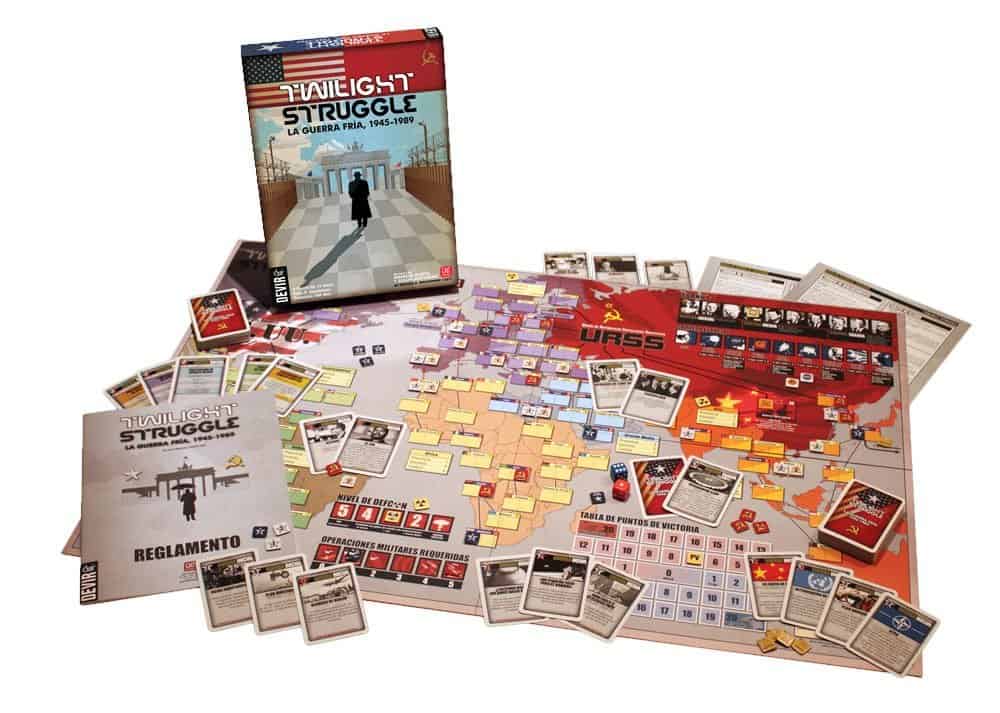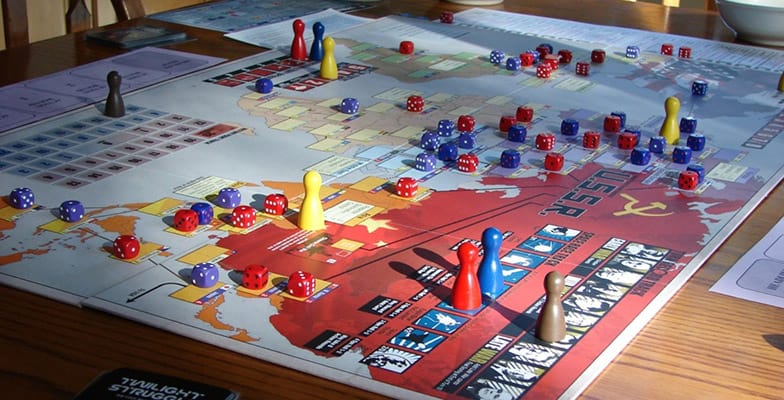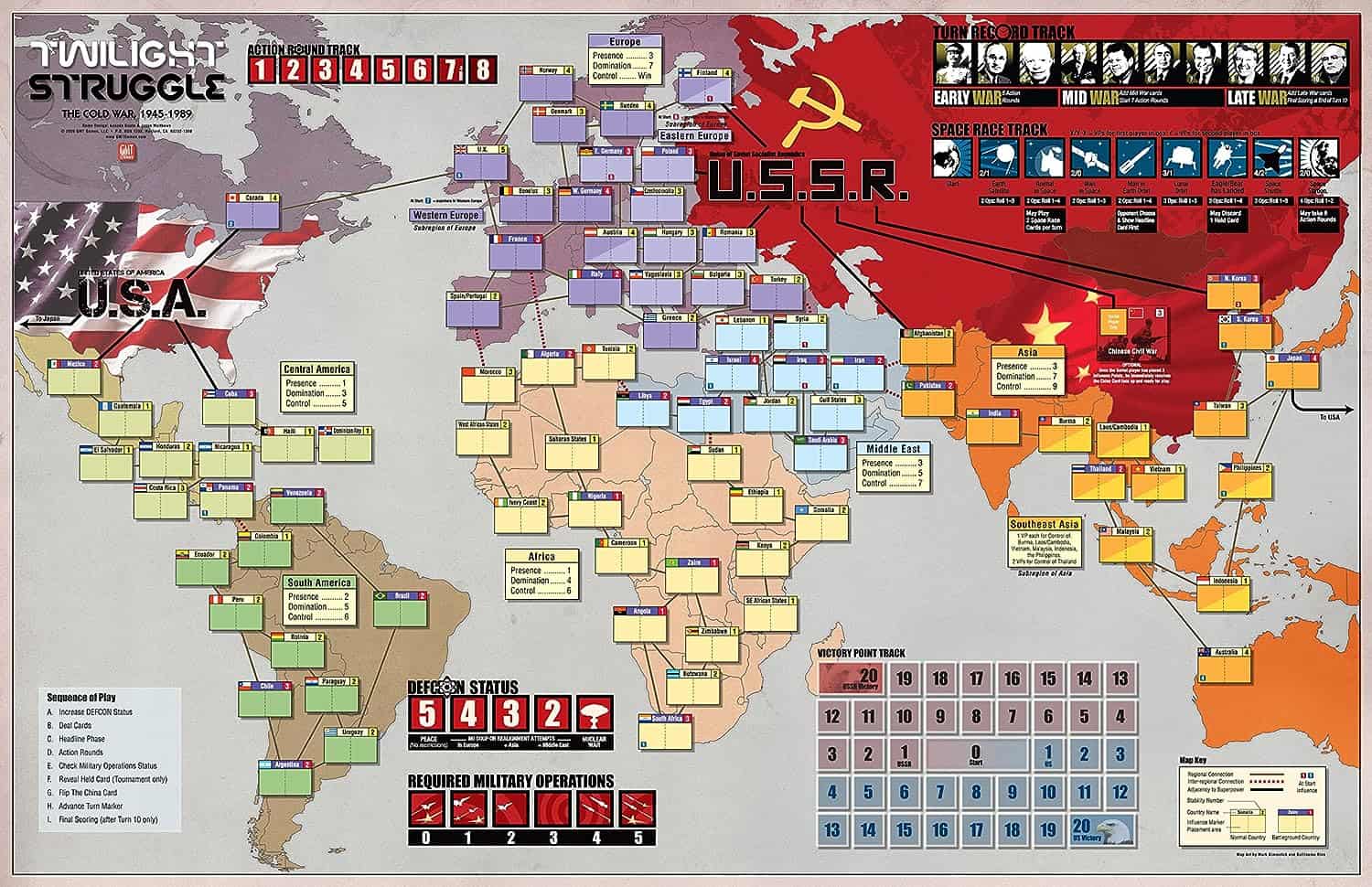Twilight Struggle is a two-player board game that transports players back to the height of the Cold War, allowing them to reenact the intense political and military struggles between the United States and the Soviet Union.
With a board spanning from the early 1940s to the late 1980s, players take on the roles of these superpowers, navigating the complex landscape of global politics. The game combines elements of strategy, historical events, and card-driven gameplay to create an immersive experience.
The heart of Twilight Struggle lies in the use of cards representing historical events. Players must carefully manage their hand of cards, deciding when to trigger events for their own benefit or for the detriment of their opponent.
As players vie for control over regions, attempt coups, and engage in a battle of influence and ideology, Twilight Struggle captures the tension and high stakes of the Cold War, making it a compelling and thought-provoking gaming experience.
What’s included in Twilight Struggle

- Game board representing the world divided into regions.
- A deck of cards with historical events.
- Tokens to track influence in regions.
- Control markers for scoring.
- Military operations markers.
- DEFCON track.
- Scoring cards for each region.
How to play Twilight Struggle

Setup
- Place the game board in the center.
- Set the DEFCON track to level 5.
- Shuffle the deck of cards and deal each player 8 cards.
- Place influence markers on the board according to the starting setup provided in the rulebook.
- Determine the starting player.
Rules for Twilight Struggle
Twilight Struggle is played over a series of turns, with each turn consisting of the following phases:
- Headline Phase: Each player selects one card from their hand to play as a headline. These cards have a special effect that occurs at the beginning of the turn. Players reveal and resolve their headlines simultaneously.
- Action Round: Players take turns playing cards from their hand. Each card can be used for its Operations Points (OPs) to perform various actions, such as placing influence, attempting coups, realigning, or triggering events. The player can choose to use a card’s event for its effect, but if it’s an opponent’s event, that event takes precedence.
- Scoring Round: After all cards are played, players check if any region scoring cards have been revealed. If so, the scoring for those regions occurs. Players gain or lose points based on their influence in the scored regions.
- Military Operations Phase: Players gain or lose Military Operations Points (MIL-OPS) based on the DEFCON level. Players lose points for failing coups or realignments. If the DEFCON reaches level 1, the game ends with a loss for the player who caused it.
- Space Race Phase: Players may attempt to advance their marker on the Space Race track by using cards with space values. Advancement can provide benefits or VP.
- Turn End: Check if either player has reached the Victory Point (VP) threshold for instant victory. If not, move the turn marker forward, and the next turn begins.
Winning the Game: Twilight Struggle can end in several ways:
- Victory Points: If a player reaches the VP threshold before the end of Turn 10, they win instantly.
- DEFCON: If the DEFCON level reaches 1, the player who caused it loses instantly.
- End of Turn 10: If neither player has won by this point, the player with the most VP wins. If tied, the game ends in a draw.
For the official rules, see the link below:
Strategies to employ

- Understand the Cards: Familiarize yourself with the deck of cards. Each card has an event and Operations Points (OPs). Know which cards are critical events that you want to trigger or avoid.
- Control Key Regions: Focus on controlling key regions, especially battlegrounds. Controlling these regions not only earns you Victory Points (VP) but also limits your opponent’s options.
- Balance the DEFCON: Be mindful of the DEFCON level. Don’t put yourself in a position where you might accidentally trigger a DEFCON loss. Conversely, try to force your opponent into such a situation if possible.
- Scoring Timing: Time your plays to maximize scoring opportunities. If you have control of a region, consider holding off on the scoring card until you’ve expanded your influence further or your opponent has reduced theirs.
- Event Management: Use your opponent’s events to your advantage when possible. If you can’t avoid triggering an opponent’s event, try to minimize its impact or use it strategically.
- Headline Phase: Choose your headline card wisely. Consider the potential impact of your opponent’s headline card as well. Sometimes, you may want to play a weak event as your headline to minimize its impact.
- Space Race: Don’t neglect the Space Race. Advancing your marker on the Space Race track can provide significant benefits and VP.
- Realignment and Coups: Use realignment and coups strategically to weaken your opponent’s influence in regions. Realignment is often a safer option than coups, but both can be effective.
- Know Your Opponent: Pay attention to your opponent’s strategy and tendencies. Adapt your playstyle to counter their moves and exploit their weaknesses.
- Late War Focus: In the late war, the game can swing dramatically. Focus on securing regions and triggering scoring cards to gain VP quickly.
- Balance VP and Influence: While earning VP is crucial, don’t neglect your influence on the board. A strong presence can help you control regions and respond to your opponent’s moves.
- Containment and Defcon: The Containment card is valuable for reducing DEFCON. Consider playing it when DEFCON is high to limit your opponent’s actions.
- Adapt and Learn: “Twilight Struggle” is a game of strategy and adaptation. Learn from your mistakes and your opponent’s moves, and refine your strategy over time.
Remember that “Twilight Struggle” is a game of historical context and strategy. Each card played and each decision made can have far-reaching consequences. With practice and a deep understanding of the game’s mechanics, you can become a formidable player in this Cold War-era struggle for global dominance.